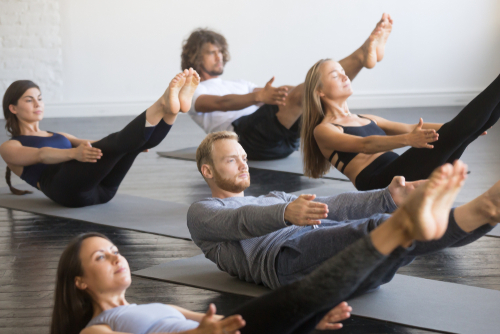There are a number of major muscles that make up your core. These are located deep within your trunk and include the muscles in your back, your abdominals, the gluteus muscles in your buttocks and the muscles in your thighs. They perform like a strong corset, holding everything in your torso together; they stabilize your spine, protect your internal organs, help to generate power and make it easier for you to perform everyday activities, such as walking, running, bending and lifting. Having a strong core is nothing to do with aesthetics, such as having a six-pack or a flat stomach; it’s a crucial aid to staying fit and healthy for everyone, as well as being an essential attribute for serious athletes and sportsmen.
A weak core is one of the chief reasons why people suffer with fatigue, poor posture and difficulty in getting up from a seated position or sitting up in bed. It may give rise to pain in the lower back, hip, knee and shoulder, because those areas tend to be over-exerted to compensate for the lack of stability, control and balance that are needed to move correctly and effectively and that a strong core provides.
Some of the recommended exercises that help strengthen the core muscles include: -
Planks & variations
- Lie on your front with your fists clasped, elbows pushed into your sides, forearms on the floor and toes tucked under.
- Push your bodyweight up so that it’s resting on your forearms and feet, in a straight line parallel to the floor.
- Squeeze the muscles in your bottom and thighs and push your heels together, while pulling up on your pelvic floor.
- Check your back and bottom aren’t sticking up or caving in (tuck your pelvis under to switch on your lower abs) and that you are making a straight line from heels to head, so that your neck is parallel to the floor.
- For variations on this exercise, such as plank shoulder taps, plank reaches, high to low plank and side planks, consult a personal trainer or fitness instructor for advice or have a look at online videos.
Deadbugs
- Lie on your back and bend your knees so your feet are flat on the floor.
- Tighten your abs and raise your bent legs so your knees are over your hips, bringing both arms up at right angles to your body.
- Move one arm back to the floor while straightening out the opposite leg and not letting it touch the floor.
- Keep your abs tight as you come back to the starting position.
- Repeat on the other side.
Bridges
- Lie on your back with bent knees and your feet flat on the floor. Keep your arms at your sides with palms down.
- Lift your hips off the ground until your knees, hips and shoulders form a straight line, pushing your pelvis towards the ceiling.
- Hold for a few seconds and slowly ease yourself back down to the starting position.
Bird dog
- Kneel on all fours with knees hip-width apart and hands firmly placed on the ground about shoulder-width apart. Brace the abdominal muscles by pulling your belly button towards your spine.
- Point one arm out straight in front and extend the opposite leg behind you. You should form one straight line from your hand to your foot, keeping hips squared to the ground.
- Hold for a few seconds then return your hands and knees to the starting position.
- Keep the abs engaged throughout the entire exercise, and work to minimise any extra motion in your hips during the weight shift. Start with 3 sets of 8 on each side.
- Leg raise
- Lie on your back with legs straight and together and arms by your side.
- Keeping your legs straight, lift them up to the ceiling until your bottom lifts off the floor.
- Slowly lower your legs until they’re just above the floor and hold for a few seconds.
- Raise you legs back up and repeat a few times.
To make sure you use the correct technique when performing core-strengthening exercises, it’s advisable to consult a fitness professional or try a class such as Core Stability or Core on the Floor.
This blog was created with advice from fitness professional and personal trainer, Cheryl Parker, who specialises in core strength and endurance training. She says, “As a power-lifter I use core strength to help me brace through the movements I perform, but core strength is important not just in the gym but for the movements we perform every day. Think of the core as just that, the “core” of your body holding everything together and protecting all your vital organs and spinal cord. Why wouldn’t you want that to be strong?”
![]()
![]()
![]() blog
blog![]()
![]()
![]() blog
blog